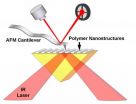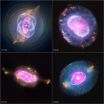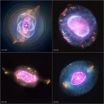(Press-News.org) Catalysts are substances that speed up the rates of chemical reactions without themselves being chemically changed. Industrial catalysts come in two main types - heterogeneous, in which the catalyst is in a different phase from the reactants; and homogeneous, in which catalyst and the reactants are in the same phase. Heterogeneous catalysts are valued for their sustainability because they can be recycled. Homogeneous catalysts are valued for their product selectivity as their properties can be easily tuned through relatively simple chemistry.
Researchers with the U.S. Department of Energy (DOE)'s Lawrence Berkeley National Laboratory (Berkeley Lab) have combined the best properties of both types of industrial catalysts by encapsulating nanoclusters of a metallic heterogeneous catalyst within the branched arms of the molecules known as dendrimers.
The results are heterogenized homogeneous nanocatalysts that are sustainable and feature high reactivity and selectivity. Furthermore, these heterogenized homogeneous nanocrystals hold promise for bridging the gap between industrial catalysts, which carry out simple reactions, and a third type of catalyst, the proteins known as enzymes, that nature uses to carry out the complex reactions of biochemistry.
"Using cyclopropanation reactions catalyzed by dendrimer-encapsulated gold and other metal nanoclusters, including platinum, palladium and rhodium, we have demonstrated that changing the dendrimer properties allows catalytic reactivity in a heterogeneous catalyst to be tuned in a similar fashion to ligand modification in a homogeneous catalyst," says world renowned catalysis chemist Gabor Somorjai, one of the leaders of this research. "Furthermore, we have shown that these heterogeneous catalysts employed in a fixed-bed flow reactor allow fine control over the residence time of the reactants and thus enable control over product distribution in a way that is not easily available for homogeneous catalysts."
Somorjai is a senior scientist with Berkeley Lab's Materials Sciences Division, where he directs the Surface Science and Catalysis Program, and a professor of chemistry with the Chemistry Department at the University of California Berkeley. He is the corresponding author along with chemist Dean Toste, who also holds joint appointments with Berkeley Lab and UC Berkeley, of a paper describing this research in the journal Nature Chemistry. The paper is titled "Control of selectivity in heterogeneous catalysis by tuning nanoparticle properties and reactor residence time." Other authors were Elad Gross and Jack Hung-Chang Liu.
Catalysts are used to initiate virtually every industrial manufacturing process that involves chemistry. Metal catalysts have been the traditional workhorses, but in recent years nano-sized catalysts have surged in importance.
"From our work, it has become increasingly clear that at the molecular level, all catalysts – heterogeneous, homogeneous and enzymes – function the same," Somorjai says. "We have now proven that working with metal nanoclusters, the same chemistry can be done with heterogeneous or homogeneous catalysts."
Adds corresponding author Dean Toste, "It's an exciting prospect that there may be universal design principles that can be applied to constructing 100-percent selective catalysts, whether they are homogeneous or heterogeneous. Ultimately, if these principles can be uncovered, it should be possible to design complex networks of selective catalysts that generate products with high efficiency."
The key to the success of this latest research was the encapsulation of metal nanoparticles inside dendrimers. The term "dendrimer" comes from the Greek word for "tree," an apt description for branching polymer molecules that resemble a worm's eye view of a tree's root system. Somorjai, Toste and their co-authors used gold nanoclusters and polyamidoamine (PAMAM), a common class of dendrimers suitable for numerous applications in materials and biotechnology. They successfully tested their dendrimer-encapsulated catalyst on cyclopropane, a biomolecule widely used in the pharmaceutical and chemical industries, and typically formed through homogeneous catalysis.
"By designing the molecular architecture of our catalyst to feature a highly crowded matrix, we greatly enhanced the product selectivity of our reaction, similar to the use of bulky ligands in a homogeneous catalyst," says Elad Gross, the lead author of the Nature Chemistry paper and a member of Somorjai's research group. "Product selectivity was further enhanced by employing the catalyst in a flow reactor and changing the flow rate of the reactants. This gave us a high degree of control over our secondary reactions, again similar to the role that ligand electronic properties play in tuning the chemical selectivity of homogeneous catalysts."
Given that flow systems are widely used in industrial chemistry, the concept of replacing homogeneous catalysts with dendrimer-encapsulated heterogeneous catalysts whose product selectivity can be controlled should be a popular alternative. For example, the catalysis of cyclopropane could be tuned to favor the formation of cyclopropanes that are critical components of cancer and cholesterol medicines. The recyclability of these dendrimer-encapsulated heterogeneous catalysts is another major advantage.
"Highly selective catalysts, especially those that can be recycled readily, are vital for the development of sustainable chemical processes," Gross says. "In the future, with our technique it should be possible to combine heterogeneous and homogeneous catalysts to get specific products with very high selectivity."
INFORMATION:
This research was supported by the DOE Office of Science.
Lawrence Berkeley National Laboratory addresses the world's most urgent scientific challenges by advancing sustainable energy, protecting human health, creating new materials, and revealing the origin and fate of the universe. Founded in 1931, Berkeley Lab's scientific expertise has been recognized with 13 Nobel prizes. The University of California manages Berkeley Lab for the U.S. Department of Energy's Office of Science. For more, visit www.lbl.gov.
DOE's Office of Science is the single largest supporter of basic research in the physical sciences in the United States, and is working to address some of the most pressing challenges of our time. For more information, please visit the Office of Science website at science.energy.gov/.
The best of both catalytic worlds
Berkeley Lab researchers develop new technique for heterogenizing homogenous nano catalysts
2012-10-11
ELSE PRESS RELEASES FROM THIS DATE:
Mine your business: Text mining insights from social media
2012-10-11
NEW YORK - October 10, 2012 - Thanks to blogs, online forums, and product review sites, companies and marketers now have access to a seemingly endless array of data on consumers' opinions and experiences. In principle, businesses should be able to use this information to gain a better understanding of the general market and of their own and their competitors' customers.
Yet this wealth of consumer-generated content can be both a blessing and a curse. A new approach, described in a study by Oded Netzer, the Philip H. Geier Jr. Associate Professor at Columbia Business School, ...
Light might prompt graphene devices on demand
2012-10-11
HOUSTON – (Oct. 10, 2012) – Rice University researchers are doping graphene with light in a way that could lead to the more efficient design and manufacture of electronics, as well as novel security and cryptography devices.
Manufacturers chemically dope silicon to adjust its semiconducting properties. But the breakthrough reported in the American Chemical Society journal ACS Nano details a novel concept: plasmon-induced doping of graphene, the ultrastrong, highly conductive, single-atom-thick form of carbon.
That could facilitate the instant creation of circuitry – ...
Fly like an eagle: New launch and recovery system takes UAV into the future
2012-10-11
A shipboard-capable system designed to support both the launch and recovery of the Scan Eagle unmanned aerial vehicle (UAV) successfully completed final demonstration flight testing Sept. 27 at a testing range in eastern Oregon.
Sponsored by the Office of Naval Research (ONR), the Compact Launch and Recovery System (CLRE) will provide a small-scale solution for the unmanned surveillance craft's operations.
"This system's shipboard capability is unique," said John Kinzer, who manages ONR's Air Vehicle Technology Program. "It's more compact than other systems, so you ...
Improving nanometer-scale manufacturing with infrared spectroscopy
2012-10-11
One of the key achievements of the nanotechnology era is the development of manufacturing technologies that can fabricate nanostructures formed from multiple materials. Such nanometer-scale integration of composite materials has enabled innovations in electronic devices, solar cells, and medical diagnostics.
While there have been significant breakthroughs in nano-manufacturing, there has been much less progress on measurement technologies that can provide information about nanostructures made from multiple integrated materials. Researchers at the University of Illinois ...
The good, the bad, and the guilty: Anticipating feelings of guilt predicts ethical behavior
2012-10-11
From politics to finance, government to education, ethics-related scandals seem to crop up with considerable regularity. As whistleblowers and investigative journalists bring these scandals to light, one can't help but wonder: Are there specific character traits that predispose people to unethical behavior?
Converging evidence suggests that the answer could be guilt proneness.
In a new article in Current Directions in Psychological Science, a journal of the Association for Psychological Science, researchers Taya Cohen and Nazli Turan of Carnegie Mellon University and ...
A planetary nebula gallery
2012-10-11
This gallery shows four planetary nebulas from the first systematic survey of such objects in the solar neighborhood made with NASA's Chandra X-ray Observatory. The planetary nebulas shown here are NGC 6543, also known as the Cat's Eye, NGC 7662, NGC 7009 and NGC 6826. In each case, X-ray emission from Chandra is colored purple and optical emission from the Hubble Space Telescope is colored red, green and blue.
In the first part of this survey, published in a new paper, twenty one planetary nebulas within about 5000 light years of the Earth have been observed. The paper ...
Grape consumption associated with healthier dietary patterns
2012-10-11
Sacramento, CA (October 9, 2012) – In a new observational study presented today at the Academy of Nutrition and Dietetics Food and Nutrition Conference and Exposition (FNCE) in Philadelphia, PA, researchers looked at the association of grape consumption, in the non-alcoholic forms most commonly consumed – fresh grapes, raisins and 100% grape juice – with the diet quality of a recent, nationally representative sample of U.S. children and adults. Their findings suggest that, among adults and children, consumption of grapes and grape products is associated with healthier dietary ...
Analysis finds likely voters rank health care second most important issue in presidential choice
2012-10-11
Boston, MA – A new analysis of 37 national opinion polls conducted by 17 survey organizations finds that health care is the second most important issue for likely voters in deciding their 2012 presidential vote. This is the highest that health care has been ranked as a presidential election issue since 1992. When likely voters were asked to choose from a list of issues, similar to the approach used in election-day exit polls, one in five (20%) named "health care and Medicare" as the most important issue in their 2012 voting choice, far behind "the economy and jobs" (cited ...
Cold cases heat up through Lawrence Livermore approach to identifying remains
2012-10-11
LIVERMORE, Calif. -- In an effort to identify the thousands of John/Jane Doe cold cases in the United States, a Lawrence Livermore National Laboratory researcher and a team of international collaborators have found a multidisciplinary approach to identifying the remains of missing persons.
Using "bomb pulse" radiocarbon analysis developed at Lawrence Livermore, combined with recently developed anthropological analysis and forensic DNA techniques, the researchers were able to identify the remains of a missing child 41 years after the discovery of the body.
In 1968, ...
Sweeping X-ray imaging survey of dying stars is 'uncharted territory'
2012-10-11
The death throes of dying stars are the focus of a sweeping new survey using NASA's Chandra X-ray satellite observatory.
More than two dozen astronomers have aligned their research goals to use Chandra to image a set of dying stars in the neighborhood of the Sun. The resulting X-ray images of these dying stars—called planetary nebulae—are shedding light on the violent "end game" of a Sun-like star's life.
The research team, led by Joel Kastner from Rochester Institute of Technology, won seven days of observing time with Chandra in 2011 to survey and image nearly two ...
LAST 30 PRESS RELEASES:
UVA’s Jundong Li wins ICDM’S 2025 Tao Li Award for data mining, machine learning
UVA’s low-power, high-performance computer power player Mircea Stan earns National Academy of Inventors fellowship
Not playing by the rules: USU researcher explores filamentous algae dynamics in rivers
Do our body clocks influence our risk of dementia?
Anthropologists offer new evidence of bipedalism in long-debated fossil discovery
Safer receipt paper from wood
Dosage-sensitive genes suggest no whole-genome duplications in ancestral angiosperm
First ancient human herpesvirus genomes document their deep history with humans
Why Some Bacteria Survive Antibiotics and How to Stop Them - New study reveals that bacteria can survive antibiotic treatment through two fundamentally different “shutdown modes”
UCLA study links scar healing to dangerous placenta condition
CHANGE-seq-BE finds off-target changes in the genome from base editors
The Journal of Nuclear Medicine Ahead-of-Print Tip Sheet: January 2, 2026
Delayed or absent first dose of measles, mumps, and rubella vaccination
Trends in US preterm birth rates by household income and race and ethnicity
Study identifies potential biomarker linked to progression and brain inflammation in multiple sclerosis
Many mothers in Norway do not show up for postnatal check-ups
Researchers want to find out why quick clay is so unstable
Superradiant spins show teamwork at the quantum scale
Cleveland Clinic Research links tumor bacteria to immunotherapy resistance in head and neck cancer
First Editorial of 2026: Resisting AI slop
Joint ground- and space-based observations reveal Saturn-mass rogue planet
Inheritable genetic variant offers protection against blood cancer risk and progression
Pigs settled Pacific islands alongside early human voyagers
A Coral reef’s daily pulse reshapes microbes in surrounding waters
EAST Tokamak experiments exceed plasma density limit, offering new approach to fusion ignition
Groundbreaking discovery reveals Africa’s oldest cremation pyre and complex ritual practices
First breathing ‘lung-on-chip’ developed using genetically identical cells
How people moved pigs across the Pacific
Interaction of climate change and human activity and its impact on plant diversity in Qinghai-Tibet plateau
From addressing uncertainty to national strategy: an interpretation of Professor Lim Siong Guan’s views
[Press-News.org] The best of both catalytic worldsBerkeley Lab researchers develop new technique for heterogenizing homogenous nano catalysts




